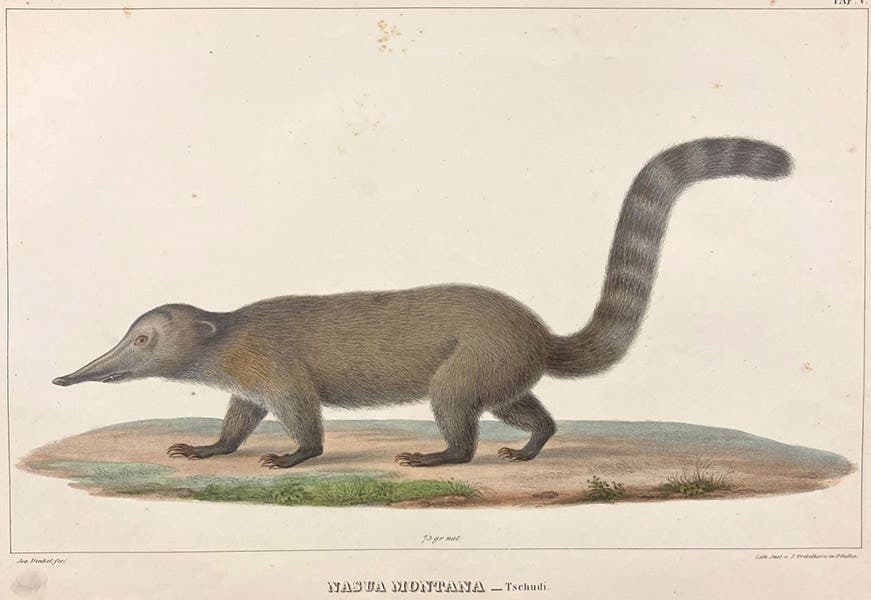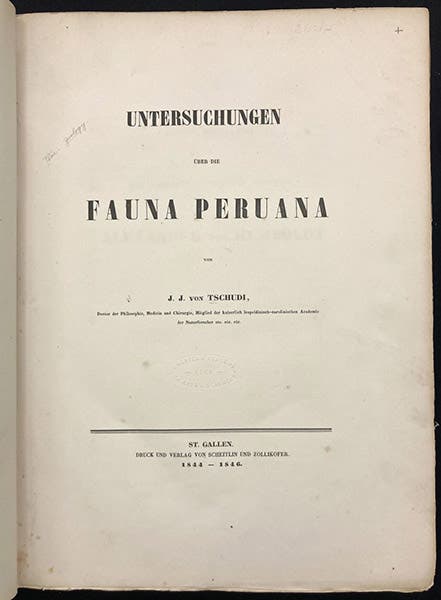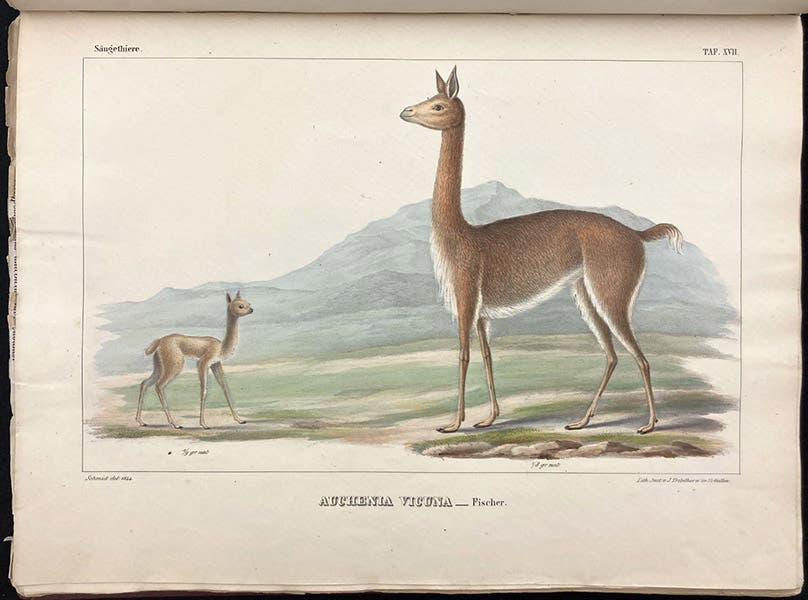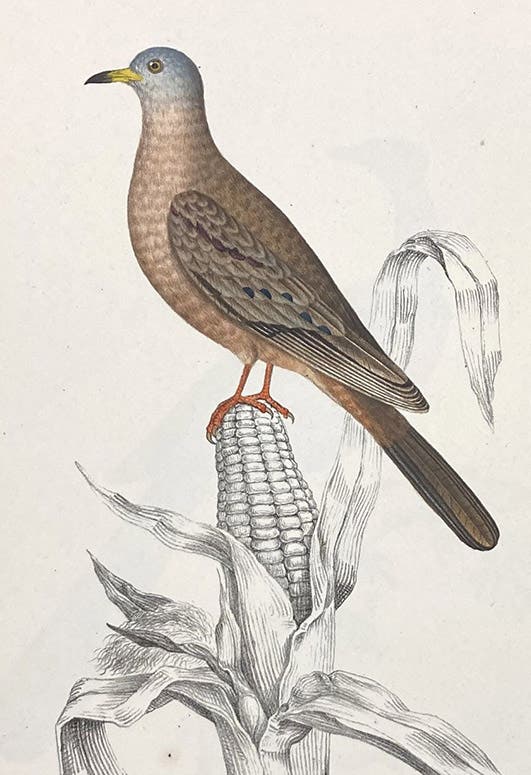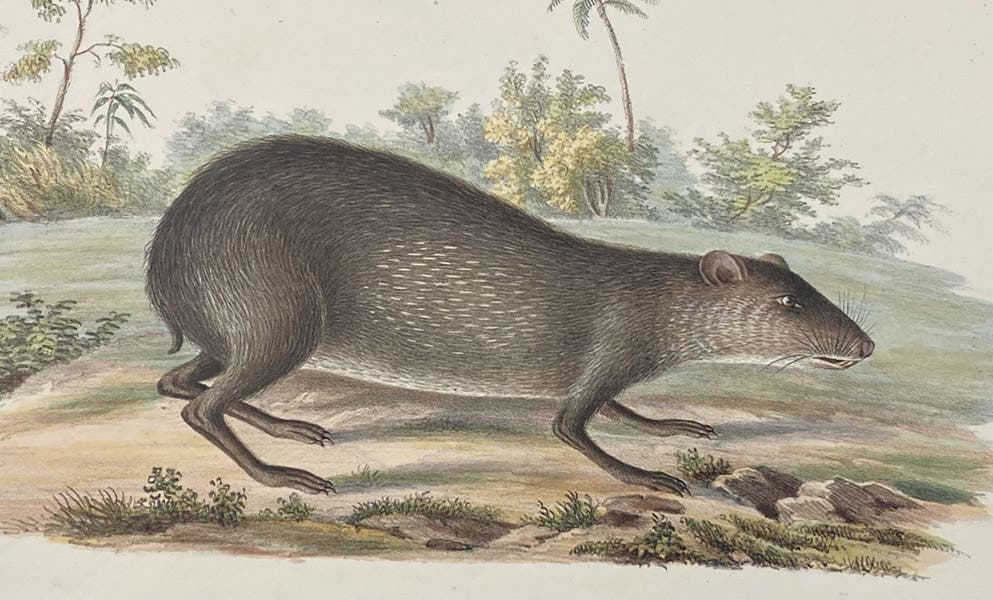Scientist of the Day - Johann Jakob von Tschudi
Johann Jakob von Tschudi, a Swiss naturalist, died on this date, Oct. 8, 1889, having been born on July 25, 1818, making him 71 years old at the time of his death. He was born in Glarus, Switzerland, and educated at Neuchâtel and Paris, studying medicine and natural history.
For reasons I have been unable to discover, Tschudi was chosen in 1838, at the tender age of 19, to go to Peru to collect specimens for a museum in Neuchâtel. He spent four years in Peru before returning with a large collection of specimens. Within 2 years, he began publishing an illustrated account of the birds and animals he had encountered, which he finished publishing in 1846. It was called Untersuchungen über di Fauna Peruana (Studies on the Fauna of Peru, 1844-46), and came out in four volumes, one each on the mammals, birds, reptiles, and fish of Peru. In most sets of the Untersuchungen, the volumes are bound together, with the 72 lithographed plates all at the end. This is the case with our copy.
We chose, as is our usual wont, the handsomest plates to reproduce here, some full page, others in close-up. The coati (first image) is nicely drawn and hand-colored (most of the plates were hand-colored). The vicuña (third image) looks majestic against one of the peaks of the Andes, and the agouti (with its gourd-like shape) would be hard to pass over (sixth image).
I am guessing that Tschudi was partial to birds, for fully half of the plates (36 of them) depict birds, many with two birds on one plate. We show the grey gull (fourth image), mainly because I really like the un-colored seashore background. We also include a ground dove, which is cleverly depicted, perched on an ear of corn (fifth image).
Over ten years ago, the Libraries of Louisiana State University (LSU) mounted a beautiful exhibition of bird illustrations called Aves; it was curated by Tom Taylor. The exhibition included Tschudi's book, or at least the volume on birds. Until recently (like last week), the digital version of the exhibition could still be viewed online, but today, we are informed that the exhibition is being "migrated" (an apt term for an exhibition on birds) to some other part of the LSU website. I will include the link in case it comes back to life in the next few months. If not, I will either try to relocate it, or remove it.
Tschudi employed some excellent artists to render his specimens into lithographs, including Joseph Dinkel, who was the personal artist for Louis Agassiz for many years, and later drew for Gideon Mantell in England. Tschudi's book was also published in St. Gallen by the notable Swiss firm of Scheitlin and Zollikofer. One might wonder how an unknown 25-year-old secured the services of such sought-after illustrators and a top-notch publisher. The answer is not hard to find: Zollikofer was Tschudi's step-father. I am sure that was a big help in launching his career in such a visually splendid fashion.
Many of Tschudi's birds were new to naturalists; a few were later named after him. One of his plates depicts two nightjars. The top one, which we show in detail (seventh image) is now referred to as Tschudi's nightjar.
We show no portrait of Tschudi, because the only one I could find, on Wikipedia, has no documentation whatsoever – it could be anyone. And besides, it shows an elderly man, which hardly represents the young explorer of the Untersuchungen. One would think that one of the institutions in Glarus or Neuchâtel would have a portrait of a younger Tschudi. I will keep looking.
William B. Ashworth, Jr., Consultant for the History of Science, Linda Hall Library and Associate Professor emeritus, Department of History, University of Missouri-Kansas City. Comments or corrections are welcome; please direct to ashworthw@umkc.edu.


